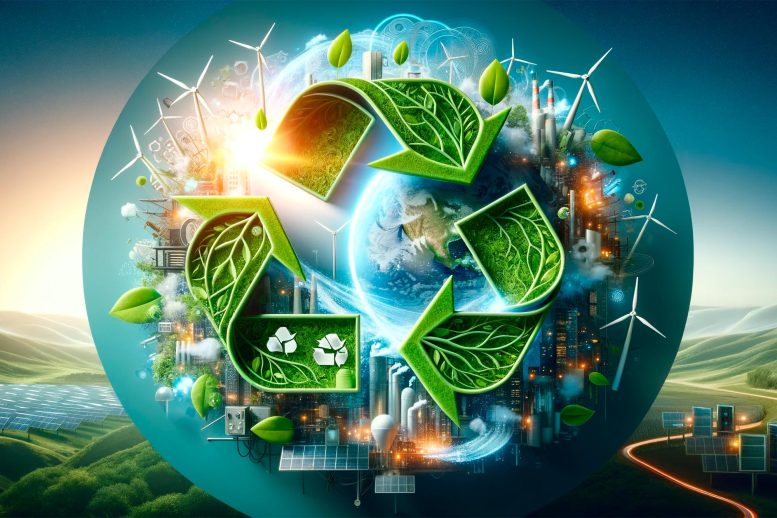
The University of Oxford proposes a plan for a sustainable plastic economy, focusing on reduced demand, renewable resources, increased recycling, and cleaner production methods. Credit: SciTechDaily.com
Oxford researchers outline a roadmap for a sustainable, net zero plastic economy, advocating for reduced demand, renewable raw materials, a significant increase in recycling, and integration with renewable energy.
Researchers from the Oxford Martin Programme on the Future of Plastics, University of Oxford, have outlined ambitious targets to help deliver a sustainable and net zero plastic economy. In a paper published in Nature, the authors argue for a rethinking of the technical, economic, and policy paradigms that have entrenched the status quo, one of rising carbon emissions and uncontrolled pollution.
The Current State of Global Plastics
Currently the global plastics system results in over 1 gigatonnes per annum (Gt/annum) of carbon dioxide equivalent emissions which is the same as the total combined emissions of Europe’s three largest economies (UK, Germany, and France).[1] If left unchecked, these emissions could rise to 4-5 Gt/annum with other sources of pollution also causing concern.[2] Another problem is the lack of effective recycling – in 2019, only 9% of the world’s plastic waste was turned into new products through mechanical recycling. The majority ended up in landfills or was incinerated, and a significant proportion was mismanaged, ending up polluting terrestrial and marine ecosystems.[3]
Proposed Interventions and Targets
The authors analyze the current and future global plastics system, proposing technical, legal, and economic interventions from now until 2050 to allow it to transition to net zero emissions and to reduce other negative environmental impacts. The study includes a future scenario centered on four targets:
Reducing future plastics demand by one-half, substituting and eliminating over-use of plastic materials and products.Changing the way plastics are manufactured to replace fossil fuels as the hydrocarbon source to use only renewable raw materials, including waste biomass and carbon dioxide.For plastics that are recoverable, maximizing recycling very significantly, targeting 95% recycling of those materials that are retrievable from wastes.Integrating plastic manufacturing and recycling with renewable power and minimizing all other negative environmental impacts, including of additives.The Need for Collective Action
The authors emphasize the need for concerted action across all four target areas to ensure the global plastics systems curb their climate impacts and meet UN Sustainable Development Goals.
Charlotte Williams, Professor of Chemistry at the University of Oxford’s Department of Chemistry and lead author said:
“We need plastics and polymers, including for future low-emission technologies like electric vehicles, wind turbines, and for many essential everyday materials. Our current global plastics system is completely unsustainable, and we need to be implementing these series of very bold measures at scale, and fast. This is a solvable problem but it needs coherent and combined action, particularly from chemical manufacturers.”
Designing a Sustainable Future for Plastics
To successfully transition the plastics system, the authors set out principles to ensure “smart materials design” and differentiate between plastics that are recoverable and irretrievable after use, noting that there is not a one-size-fits-all solution. Rather, the authors propose careful use of the design principles to help select the optimum production methods and appropriate use of resources, deliver the required performances, ensure waste management, and minimize broader environmental impacts. A timeline of technical-economic-policy and legal interventions helps readers focus on the actions needed to reach net zero emissions by 2050.
Urgent Call to Action
“The time for action has arrived, we cannot afford to wait any longer,” study co-author Fernando Vidal, Postdoctoral Researcher in Chemistry at POLYMAT in Spain and former Oxford Martin School Fellow on the Future of Plastics concluded.
“We must change our concepts around the way we make, use, and dispose of plastics, otherwise, we risk perpetuating this problem. The upcoming UN Global Plastic Treaty is the opportunity to make a lasting change in the right direction.”
Study co-author Cameron Hepburn, Battcock Professor of Environmental Economics at Oxford’s Smith School of Enterprise and the Environment, said: “The problem is that plastics, while contributing hugely to global pollution and greenhouse gas emissions, are extraordinarily useful. Our research finds that creating a circular economy for plastics in order to reduce their negative impacts is possible, but only if we can reduce future demand by half, switch to renewable plastics that aren’t made from fossil fuels, recycle 95% of what’s left, and minimize environmental impacts at every step of the process.
“The challenge is enormous, but we present a roadmap to transform the whole system, including through the smart design of plastics, economic and legal interventions, and a shift away from overconsumption.”
Notes:
“Strategies to reduce the global carbon footprint of plastics” by Jiajia Zheng, and Sangwon Suh, 15 April 2019, Nature Climate Change.
DOI: 10.1038/s41558-019-0459-z“Towards circular plastics within planetary boundaries” by Marvin Bachmann, Christian Zibunas, Jan Hartmann, Victor Tulus, Sangwon Suh, Gonzalo Guillén-Gosálbez and André Bardow, 6 March 2023, Nature Sustainability.
DOI: 10.1038/s41893-022-01054-9Global Plastics Outlook: Economic Drivers, Environmental Impacts and Policy Options
Reference: “Designing a Circular Carbon and Plastics Economy for a Sustainable Future” 31 January 2024, Nature.
DOI: 10.1038/s41586-023-06939-z
>>> Read full article>>>
Copyright for syndicated content belongs to the linked Source : SciTechDaily – https://scitechdaily.com/oxfords-bold-plan-for-a-zero-carbon-circular-plastics-economy/